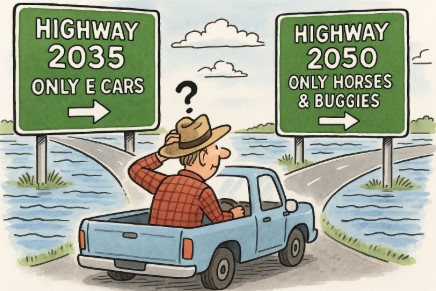
URGENT UPDATE: Australia’s newly announced 2035 carbon targets are raising alarm bells among farmers, signaling potential financial ruin for many in the agricultural sector. With compliance costs buried deep in the supply chain, producers are bracing for a devastating impact on their bottom lines.
The government’s Safeguard Mechanism targets facilities emitting over 100,000 tonnes of CO2-e annually, encompassing critical areas like chemicals, fertilizers, and fuel. As companies struggle to meet these stringent requirements, the costs will inevitably trickle down to farmers, who are already facing escalating expenses.
Officials report that under the 2035 targets, emission reduction baselines will steeply decline, requiring businesses to cut emissions faster year by year. This shift means that as suppliers exceed their baselines, they will have to purchase carbon offsets, which will lead to higher prices for essential inputs like fuel and fertilizer. As one farmer noted, “Costs roll downhill, and the farm gate is always at the bottom of the hill.”
The National Farmers Federation and the Australian Farm Institute (AFI) have yet to provide specific data on the projected impact of these targets. However, ABARES modeling indicates that decarbonization policies could increase energy-intensive input prices by 10-30%, with fertilizer and diesel being the most vulnerable. This could translate into an additional $200,000 in costs for a typical 4,000-hectare WA wheat-sheep farm by 2035.
Farmers are expressing skepticism about the government’s assurances regarding electricity prices and job creation. “The federal government is in denial,” one farmer stated, referring to previous promises that failed to materialize. Critics argue that the government’s carbon measures, branded with neutral or positive labels, disguise the reality of compliance costs.
The urgent question remains: What will be the cost burden on farmers under the new regulations? Without transparent modeling, producers are left in the dark, forced to navigate a complex web of rising costs and regulatory compliance.
As Australian farmers face an uncertain future, compliance with the 2035 carbon targets may threaten their long-term sustainability. The looming risk of lost productivity and increased input costs raises concerns about the viability of family farms.
With Woodside and Hancock Prospecting reportedly considering investments in land to offset emissions, the trend of carbon farming is set to escalate. This could further squeeze agricultural land availability while pushing up land prices, creating a troubling scenario for family farmers who may feel pressured to sell out.
As Australia approaches 2050 with its ambitious net-zero goals, the impacts of these carbon targets are already being felt across the agricultural landscape. Farmers, many of whom are still unaware of the full implications of the Safeguard Mechanism, must act quickly to prepare for the financial challenges ahead.
The urgency is clear: unless the government provides specific cost modeling for the 2035 targets, farmers risk being blindsided by a carbon cost trap that their international competitors will not face. With the stakes so high, it is critical for producers to stay informed and advocate for transparency in policy-making.
As the situation develops, farmers are urged to engage with industry bodies and demand clarity on how these carbon targets will affect their livelihoods. The time to act is now, as Australia marches forward into a carbon-compliant future fraught with uncertainty for its agricultural sector.







